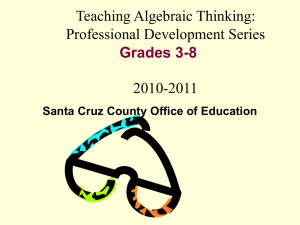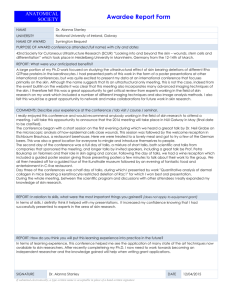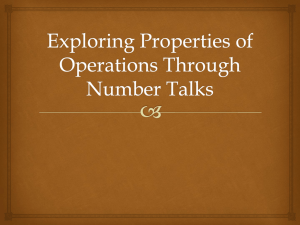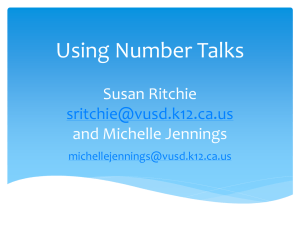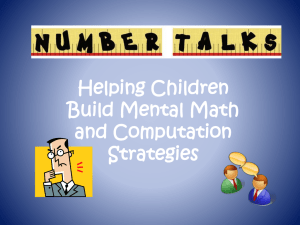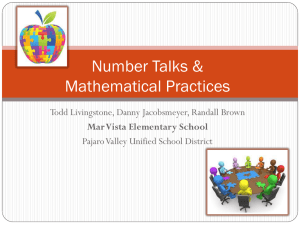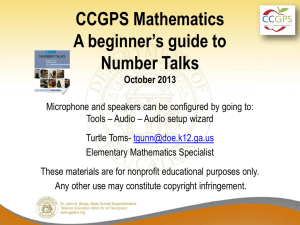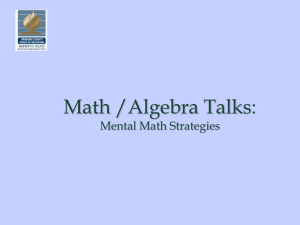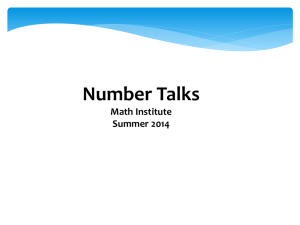NUMBER TALKS
advertisement
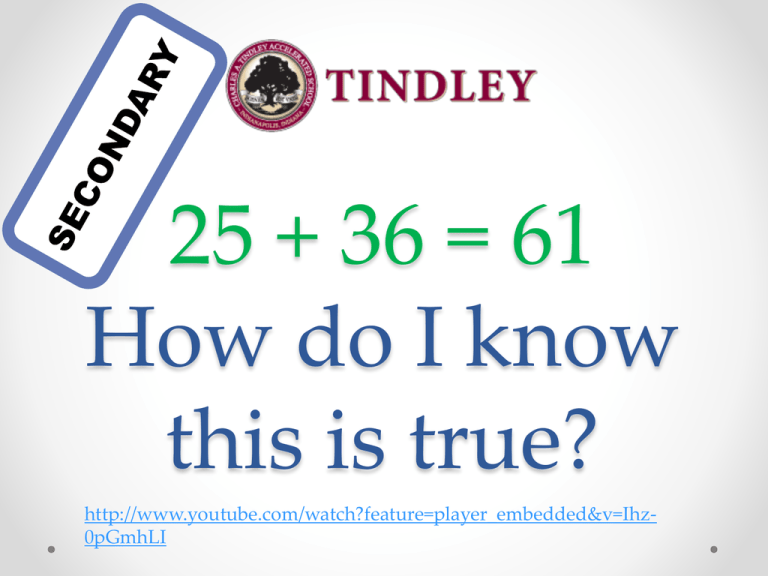
25 + 36 = 61 How do I know this is true? http://www.youtube.com/watch?feature=player_embedded&v=Ihz0pGmhLI NUMBER TALKS Fraction of the Day Everyday THE EXPECTATION Every secondary math class operated by TAS will start with a NUMBER TALK. Every elementary school operated by TAS will have a 30 minute NUMBER TALK block. NUMBER TALKS • AIM: 2 minutes o Teachers will know what a number talk is and how to use it in an everyday classroom setting by practicing, creating, and reviewing number talk activities. • DO NOW: 2 minutes + 2minutes o Teachers will write a mini essay that outlines the true purpose of math. • ACTIVITY: 45 minutes o o o o o Learn about what NTs are. Participate in 5-10 NTs (Be prepared to be video taped) Invent Norms for your classroom Create 5 Number Talks Practice 1 of your talks with your table. (Be prepared to be video taped) • HW: o Have 5 Number Talks planned, typed, and returned to your school leader by the next day. NUMBER TALKS • DO NOW: o Teachers will write a mini essay that outlines the true purpose of math. NUMBER TALKS • ACTIVITY: o o o o o Learn about what NTs are. Participate in 5-10 NTs Invent Norms for your classroom Create 5 Number Talks Practice 1 of your talks with your table. NUMBER TALK • What are Number Talks? o A Number Talk is a short, ongoing daily routine that provides students with meaningful ongoing practice with computation. A Number Talk is a powerful tool for helping students develop computational fluency because the expectation is that they will use number relationships and the structures of numbers SHORT ONGOING DAILY MENTAL PRACTICE MEANINGFUL SIMPLE TO COMPLEX NUMBER TALK • Primary Goals – Computational Fluency "Computational fluency refers to having efficient and accurate methods for computing. Students exhibit computational fluency when they demonstrate flexibility in the computational methods they choose…” #s ARE MADE OF SMALLER #s #s CAN BE TAKEN APART OR COMBINED WHAT WE KNOW ABOUT THE SMALL CAN HELP US WITH THE BIG #s ARE ORGANIZED INTO GROUPS OF 10s Note: numbers can be substituted with elements THE PROCESS 1. TEACHER PRESENTS PROBLEM 2. STUDENTS FIGURE OUT ANSWER (Similar to you do) 3. STUDENTS SHARE THEIR ANSWERS 4. STUDENTS SHARE THEIR THINKING 5. THE CLASS AGREES ON THE “REAL” ANSWER 6. REPEAT WITH OTHER PROBLEMS NORMS 1. STUDENTS ARE SILENT DURING WORK TIME – SLANT means you’re done 2. STUDENTS MUST BE GIVEN AN OPPORTUNITY TO CORRECT THEMSELVES 3. STUDENTS ARE RESPECTFUL WHEN HEARING OTHER IDEAS – hands bow means you agree 4. STUDENTS ARE RESPECTFUL WHEN COMMENTING ON OTHER IDEAS 1. I respectfully disagree with Joshiba. I believe 2 is in the middle because I subtracted and did not use addition. THE PROCESS Language Assistance PROCESS STEPS TEACHER LANGUAGE TEACHER PRESENTS PROBLEM “Let’s see who will think intelligently about this problem.” “I’m ready to hear all of your marvelous takes on what the answer to this will be.” STUDENTS FIGURE OUT ANSWER (Similar to you do) “I love the hard work I see in the room.” You all are really focused in this room and I love it.” STUDENTS SHARE THEIR ANSWERS “Let me get all these down.” “I want to get as many of your thoughts down as possible. This is really helping me see how you think.” STUDENTS SHARE THEIR THINKING “Who would like to share their thinking?” “Who did it another way?” “How many solved it that way?” “How did you figure that out?” “Sam. Do you have any questions for Tom?” THE CLASS AGREES ON THE “REAL” ANSWER “Who can explain to John why the 6 should be divided?” SEE IT IN ACTION • http://www.youtube.com/watch? v=mRV-26fEq-s 6th Grade • http://www.insidemathematics.org/classroomvideos/number-talks/7th-grade-math-whats-thesavings/number-talk 7th Grade • http://numbertalks1.blogspot.com A high school teacher’s blog about her findings. NUMBER TALK 1 The number of the day is… 105 Use any of the four basic operations and at least one radical to arrive at our number. Find at least 2 solutions. REMEMBER SHORT: 5 – 8 minutes ONGOING DAILY MENTAL PRACTICE MEANINGFUL SIMPLE TO COMPLEX ALSO…REMEMBER • #s ARE MADE OF SMALLER #s #s CAN BE TAKEN APART OR COMBINED WHAT WE KNOW ABOUT THE SMALL CAN HELP US WITH THE BIG #s ARE ORGANIZED INTO GROUPS OF 10s NUMBER TALK 2 Look at the number sentence… 13 +14 = 18 + 12 – x Find the value of x. ALSO…REMEMBER #s ARE MADE OF SMALLER #s #s CAN BE TAKEN APART OR COMBINED WHAT WE KNOW ABOUT THE SMALL CAN HELP US WITH THE BIG #s ARE ORGANIZED INTO GROUPS OF 10s NUMBER TALK 3 Read the problem… Rick’s uncle Chase told him to put away 15% of his earnings every week. This week he put away $45. How much did he earn? NUMBER TALK 4 Look at the number line… 1/2 3/4 ? 3/4 is in the middle of ½ and what other number? NUMBER TALK 5 Look at the number line… 24 60 What number is half of a half of this number line? POPULAR NUMBER TALKS • Number of the Day • Number Lines • Number Strings • Concepts of Equality • Number Trains • Percentage Understandings NUMBER OF THE DAY • Select a number • Students find multiple ways to arrive to that number using calculations • Extension: They use methods you are currently studying – or whatever parameters you set (only exponents and addition). 27 9x3 52 +2 42+11 NUMBER LINES • Draw a number line and plot numbers on it • Students find the middle of two numbers or are given the middle and asked to find the edge. • Extension: Do not use whole numbers. Use fractions, integers, and decimals. 2/5 What number is in the middle of the numbers shown? 3/4 NUMBER STRINGS • Start with a simple computation that helps illustrate a rule or truth. • As students answer, make sure they describe how the simpler problem helps solve the new and how they are breaking a part numbers and putting them back together. • • • • • • • • • 2x5 4x5 8x5 16x5 32x5 48x5 48x0.5 48x0.05 48x0.25 CONCEPTS OF EQUALITY • Present student with an equation with a missing number. • Students separate, combine, alter numbers to solve the problem. 7+6 = ___+ 5 Example: Broke 6 into (1+5). Added the 1 back to 7. now I have 8+5. So the missing number is 8. 12 + 9 = 10 + 8 + c NUMBER TRAINS • Verbal examples and nothing written • Students use auditory modality to focus in on questioning to determine answer. • No order of operations used because the train goes in the order spoken. Your number is 200. Now divide by 2. Take 25% of that. Subtract 5. Find 1/5. What is your new number? PERCENTAGE UNDERSTANDINGS • Can be a number string or word problem • Students break apart and combine numbers to simplify their mental process. 10% of 780 20% of 780 23% of 780 25% of 782 Best when used with individual work and cold call. Students should use norms and habits of discussion to connect to one another. Best when used with think/pair/share or elbow partners. Or After a 20% markup, Mr. Jones paid $80 for a new pair of Sperry’s. What was the original price? CREATE • Create 5 number talks • Parameters o Each Number Talk must be on the template o Each must possess the opportunity to have students break apart and place numbers back together. o Each Number Talk must increase in rigor as it moves on. PRACTICE You are being filmed HOMEWORK Type up your 5 Number Talks using the template and deliver to your leader. REFERENCES • http://www.insidemathematics.org/classroomvideos/number-talks • http://www.mathperspectives.com/num_talks.html • http://numbertalks1.blogspot.com/ • http://www.sandi.net/cms/lib/CA01001235/Centricit y/Domain/217/High%20School%20Instructional%20R outines.pdf • http://schoolwires.henry.k12.ga.us/cms/lib08/GA010 00549/Centricity/Domain/3791/Number%20Talk%20 Overview.pdf
